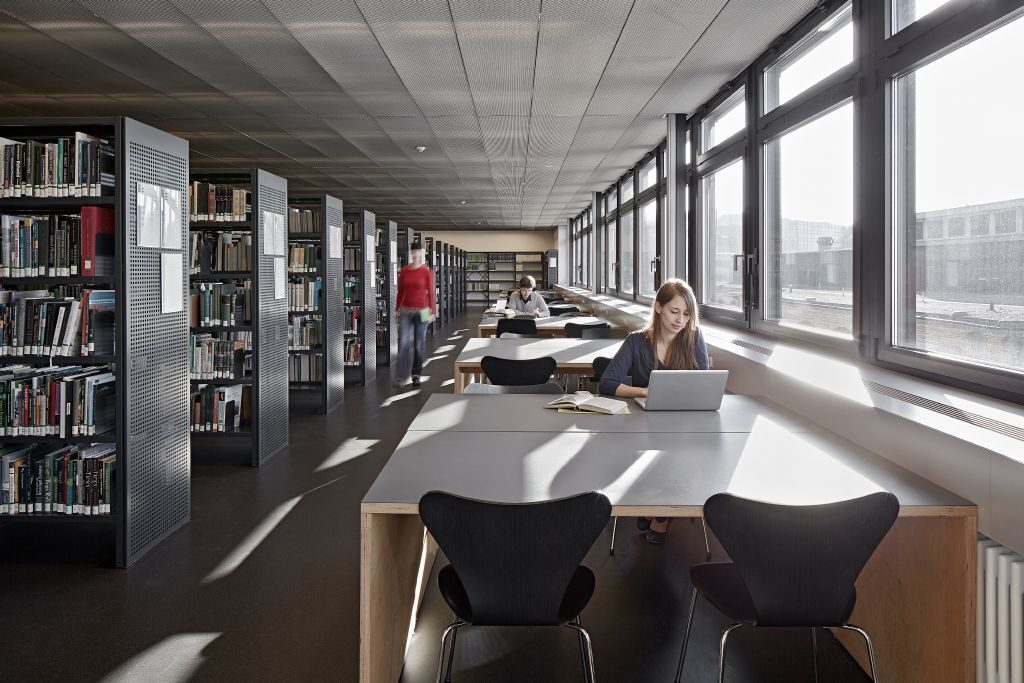The «Green Library»
The insitute libraries are merged
In 1998, considerations were made for the first time about merging the differently sized institutional libraries of the Department of Environmental Sciences (D-UWIS) and the Department of Agricultural and Food Sciences (D-AGRL) into one unit. In October 2005, the new departmental library was opened in room H43 of the CHN building.
A decision by the ETH university management in the summer of 1999, which called for a central record of all new additions to the ETH literature collection in the future, gave the Green Library project an important boost. The project really got off the ground with the support of the professors. Above all, the two professors Anton Schuler (Professor of Forest History) and Rainer Schulin (Professor of Soil Conservation) championed the project. Not least because of this, the project was successfully realised in autumn 2005.
Two libraries grow together in the "green" one
From an agricultural science perspective, there were two libraries that were transferred to the Green Library, firstly the library of the Institute of Farm Animal Sciences and secondly the IPW library of the Institute of Plant Sciences. The library of the Institute of Farm Animal Sciences was made up of several small sub-collections distributed over different floors and rooms. Thus, the library of farm animal sciences was a classical institutional library, which was practically exclusively oriented towards internal needs. The IPW library was already the result of a library merger: in 1986, the three institutes for plant cultivation, phytomedicine and general botany were merged into the Institute of Plant Sciences (IPW). Two years later, the associated institutional libraries also became one.
Soon after its founding, the IPW library connected to the digital age with PC-based software. In 2000, the IPW library joined the Network of Libraries and Information Centers in Switzerland (NEBIS), which had been created the year before, and introduced the library software Aleph along with it. Thus, the IPW holdings were henceforth part of a nationwide library network.
Forestry book collection from ETH’s founding period
Much further back than the 80s of the twentieth century dates the history of the largest library that was transferred to the Green Library: the Forestry Library. The name "Forestry Library" was first used with the move to the then new LFW building in 1914. But basic features of a "forestry book collection" (contemporary designation) can be traced back to the early days of ETH. After all, the forestry school had been part of the original polytechnic curriculum since the beginning in 1855. When the new ETHICS library network was realised in the mid-1980s, the Forestry Library was one of the first participants and was given the library code E05 (i.e. the fifth participant after the main libraries of ETH and EPFL as well as the ETH Architecture and Civil Engineering Library and the ETH Earth Sciences Library). The Green Library still bears the code E05 today. Even the transition from the ETHICS successor network, NEBIS, to the newly created Swiss Library Service Platform (SLSP) in December 2020 did not change this reminiscence of the pioneering days of library automation at ETH in the mid-1980s.
Ceremonial opening
On 25 October 2005, the project work of several years culminated in the opening of the Green Library in the CHN building as the youngest of four special libraries of the ETH Library. As part of the project, the seven sub-libraries – the two libraries of the Geobotanical Institute (GEOBOT and GEOSYST), the library of the Institute for Atmospheric and Climate Science, the library of the Institute of Terrestrial Ecosystems, the Forestry Library and the two agricultural science libraries mentioned at the beginning, the IPW library and the library of the Institute of Farm Animal Sciences – were merged into a new unit.
More than 100,000 publications were processed. To a large extent, the holdings of the source libraries first had to be recorded in the library catalogue. The original plan to integrate all literature areas of the D-AGRL into the Green Library had to be discarded for reasons of building statics. As a result, only 50,000 publications – instead of the planned 70,000 – were transferred to the Green Library. For this reason, the food science literature did not become part of the Green Library, but was moved to the ETH main building.
The later division of the D-AGRL was in a way anticipated by the distribution of the literature in the libraries. The reduced stock size in turn allowed a more airy design of the study spaces. Thanks to the close partnership with the department, innovative ideas such as the newly designed group workspaces can also be realised today. All these factors combined with the good view from the J floor make the Green Library one of the most beautiful study libraries at ETH, whose study spaces are very popular.

